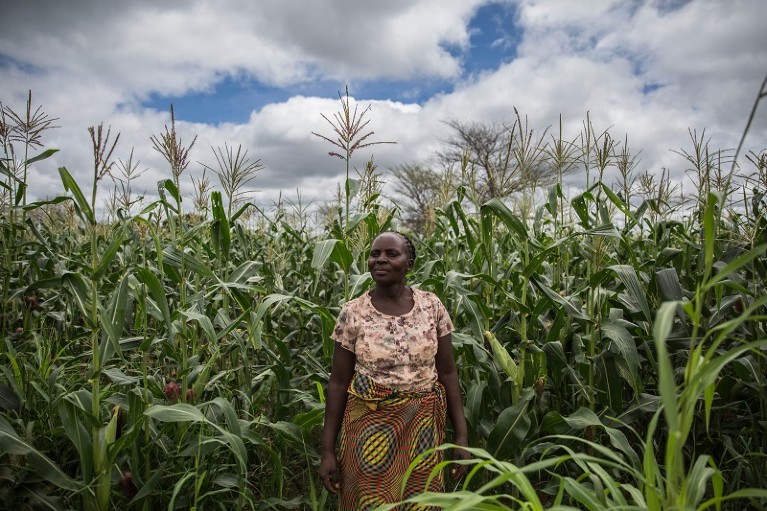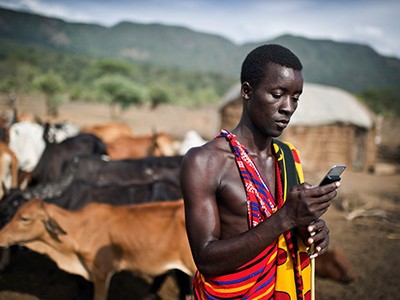
Imelda Hicoombolwa, a smallholder farmer in Zambia, is receiving help from the World Food Programme to grow crops after a severe drought last year.Credit: Guillem Sartorio/AFP/Getty
How can research help to end hunger? One way to answer this question is to assess published research on hunger, and determine which interventions can make a difference to the lives of the 690 million people who go hungry every day.
That’s what an international research consortium called Ceres2030 has been doing1. And the results of its 3-year effort to review more than 100,000 articles are published this week across the Nature Research journals2. The consortium’s findings — coming just days after this year’s Nobel Peace Prize was awarded to the World Food Programme — are both revealing and concerning.
The team was able to identify ten practical interventions that can help donors to tackle hunger, but these were drawn from only a tiny fraction of the literature. The Ceres2030 team members found that the overwhelming majority of the agricultural-research publications they assessed were unable to provide solutions, particularly to the challenges faced by smallholder farmers and their families.
The World Food Programme is the United Nations’ primary agency in the effort to eliminate hunger, which includes the Sustainable Development Goal (SDG) to end hunger by 2030. These goals represented an enormous challenge even before the current pandemic. Now, as the UN and others have been warning, the coronavirus — and efforts to contain it — will force a further 150 million people into extreme poverty by 2021. This makes the World Food Programme’s mission more urgent, and the Ceres2030 project more necessary.
A better way for countries to track their progress on sustainability
The goal to end hunger has a number of targets, and the project team — 78 researchers from 23 countries and 53 organizations — focused on assessing research that could speak to two of these targets, which were set in 2015. One target seeks to double the incomes and productivity of small-scale food producers; the other aims to make food production more environmentally friendly and more resilient to climate shocks and other disasters.
The researchers found many studies that conclude that smallholders are more likely to adopt new approaches — specifically, planting climate-resilient crops — when they are supported by technical advice, input and ideas, collectively known as extension services.
Other studies found that these farmers’ incomes increase when they belong to cooperatives, self-help groups and other organizations that can connect them to markets, shared transport or shared spaces where produce can be stored3. Farmers also prosper when they can sell their produce informally to small- and medium-sized firms4. That seems to be because such companies share information with farmers and provide sources of credit.
Research gaps
There was one finding, however, that surprised and troubled the Ceres2030 team. Two-thirds of people who are hungry live in rural areas. Of some 570 million farms in the world, more than 475 million are smaller than 2 hectares. And, in low-income countries, more than two-thirds of workers are employed on the land. Rural poverty and food insecurity go hand in hand, and yet the Ceres2030 researchers found that the overwhelming majority of studies they assessed — more than 95% — were not relevant to the needs of smallholders and their families. Moreover, few studies included original data.
By contrast, the project team found a preponderance of studies on new technologies. Every year, food rots in the field, or later on, because of inadequate storage. But nearly 90% of interventions aiming to reduce these losses looked at how well a particular tool, such as a pesticide or a storage container, worked in isolation. Only around 10% compared the many existing agricultural practices to evaluate what works and what doesn’t.
Speaking truth to power about the SDGs
Smallholders need new technologies, but they also need research on the effectiveness of existing interventions — such as whether crops such as maize (corn) are best dried on the plant or after harvest on the ground. One of the papers detailing the Ceres2030 team’s findings includes the striking statement that “most of the included studies only involved researchers without any participation from farmers”5.
This finding was not exclusive to research from academic institutions. The literature the team reviewed included research from think tanks, non-governmental organizations, many UN agencies and the World Bank. It’s clear from the review that, despite being involved in making and tracking SDG policies, such organizations are not producing nearly as much relevant research as needed.
Priority mismatch
So why aren’t more researchers answering more practical questions about ending hunger that are relevant to smallholder farmers? Many of the key reasons can be traced to the changing priorities of international agricultural-research funding.
During the past four decades, funding provision for this type of research has been shifting towards the private sector, with more than half of funding now coming from agribusinesses, according to the work of Philip Pardey, who researches science and technology policy at the University of Minnesota in Saint Paul, and his colleagues6.
At the same time, applied research involving working with smallholder farmers and their families doesn’t immediately boost an academic career. Many researchers — most notably those attached to the CGIAR network of agricultural research centres around the world — do work with smallholder farmers. But in larger, research-intensive universities, small is becoming less desirable. Increasingly, university research-strategy teams want their academics to bid for larger grants — especially if a national research-evaluation system gives more credit to research income.
Publishers also bear some responsibility. Ceres2030’s co-director, Jaron Porciello, a data scientist at Cornell University in Ithaca, New York, told Nature that the subject matter for smallholder-farming research might not be considered sufficiently original, globally relevant or world-leading for journal publication. This lack of a sympathetic landing point in journals is something that all publishers must consider in the light of the Ceres2030 team’s findings.
The Ceres2030 collaboration is to be congratulated for highlighting these issues. The group had two funders, the Bill & Melinda Gates Foundation in Seattle, Washington, and the German Federal Ministry for Economic Cooperation and Development. Both have pledged extra funding to the intergovernmental Global Agriculture and Food Security Program, which channels funding from international donors to smallholder farmers. This is important, but doesn’t fully address Ceres2030’s overarching finding: that most research on hunger is of little practical use in the goal to make hunger a thing of the past.
National research agencies, too, need to listen, because they are the major funding source for researchers in universities. There’s a place for collaborating with big businesses, but achieving the SDG to end hunger will require an order of magnitude more research engagement with smallholders and their families. Their needs — and thus the route to ending hunger — have been neglected for too long.

 Speaking truth to power about the SDGs
Speaking truth to power about the SDGs
 Reset Sustainable Development Goals for a pandemic world
Reset Sustainable Development Goals for a pandemic world
 Imagine a world without hunger, then make it happen with systems thinking
Imagine a world without hunger, then make it happen with systems thinking
 Time to revise the Sustainable Development Goals
Time to revise the Sustainable Development Goals
 A better way for countries to track their progress on sustainability
A better way for countries to track their progress on sustainability








